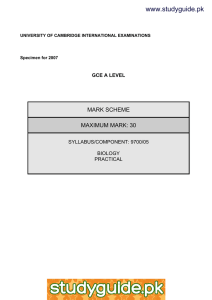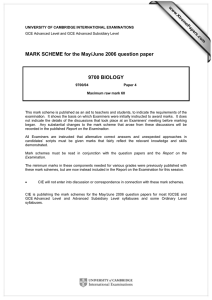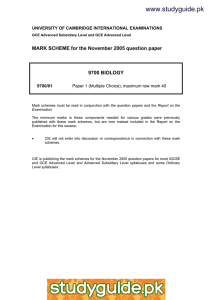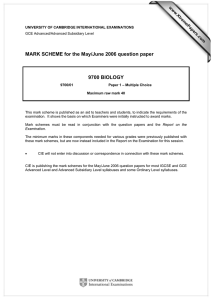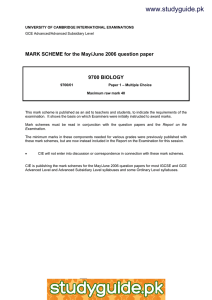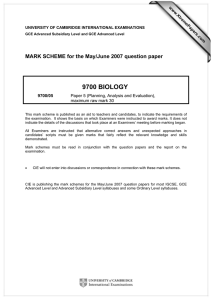9700 BIOLOGY MARK SCHEME for the May/June 2013 series
advertisement
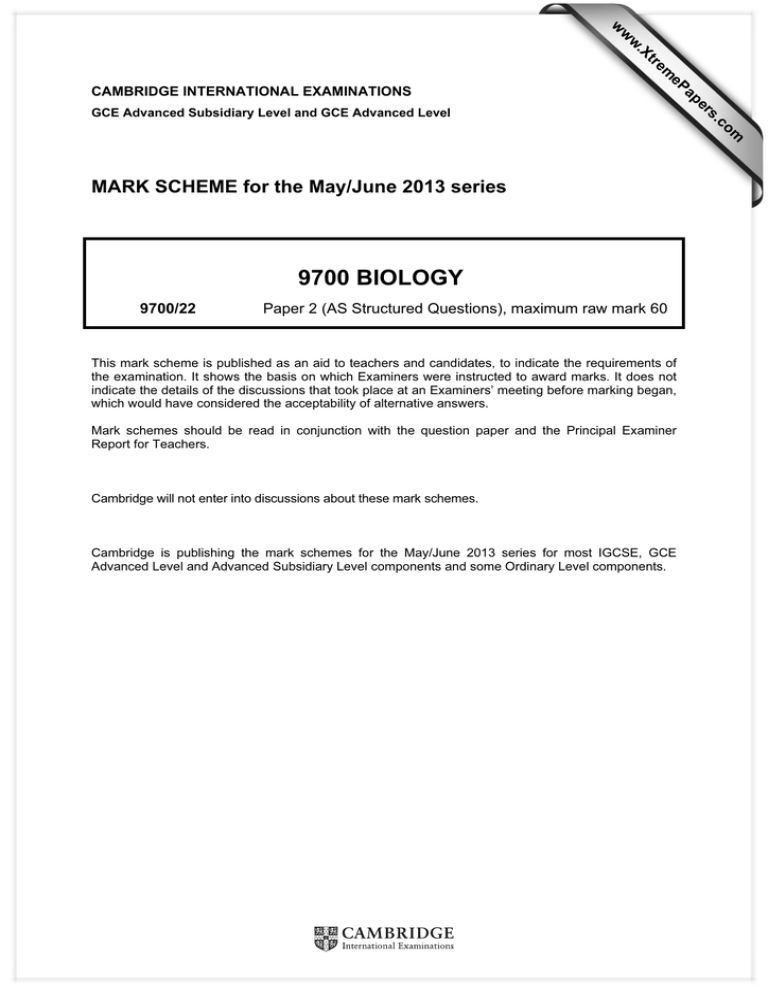
w w ap eP m e tr .X w CAMBRIDGE INTERNATIONAL EXAMINATIONS 9700 BIOLOGY 9700/22 Paper 2 (AS Structured Questions), maximum raw mark 60 This mark scheme is published as an aid to teachers and candidates, to indicate the requirements of the examination. It shows the basis on which Examiners were instructed to award marks. It does not indicate the details of the discussions that took place at an Examiners’ meeting before marking began, which would have considered the acceptability of alternative answers. Mark schemes should be read in conjunction with the question paper and the Principal Examiner Report for Teachers. Cambridge will not enter into discussions about these mark schemes. Cambridge is publishing the mark schemes for the May/June 2013 series for most IGCSE, GCE Advanced Level and Advanced Subsidiary Level components and some Ordinary Level components. om .c MARK SCHEME for the May/June 2013 series s er GCE Advanced Subsidiary Level and GCE Advanced Level Page 2 Mark Scheme GCE AS/A LEVEL – May/June 2013 Syllabus 9700 Mark scheme abbreviations: ; separates marking points / alternative answers for the same point R reject A accept (for answers correctly cued by the question, or by extra guidance) AW alternative wording (where responses vary more than usual) underline actual word given must be used by candidate (grammatical variants excepted) max indicates the maximum number of marks that can be given ora or reverse argument mp marking point (with relevant number) ecf error carried forward I ignore © Cambridge International Examinations 2013 Paper 22 Page 3 1 Mark Scheme GCE AS/A LEVEL – May/June 2013 Syllabus 9700 Paper 22 (a) (i) if one box of a pair left blank, no mark for that row mark first on row unless one row left completely blank mitosis meiosis 1 diploid / two chromosome sets / 2n haploid / one chromosome set /n 2 same number of chromosomes as half the number of chromosomes as parent / AW parent / AW ; 3 two, copies / alleles / forms, of each one, copy / allele / form, of each 4 (cells) genetically identical (to, each A (cells have) same / AW, DNA / A no genetic variation (cells) genetically different ; ; A (cells have) different / AW, DNA / genetic material A genetic variation ; [max 2] (ii) 1 for sexual reproduction ; A for, gamete / sperm and egg / pollen and ovum, formation or A gametogenesis 2 to produce, haploid cells / cells with one set of chromosomes, for, fertilisation / fusion ; A to form zygote A cells with half the number of chromosomes for, fertilisation / fusion 3 restores / AW, diploid / original, number when, fertilisation / fusion (of gametes) occurs ; only need ref. to fertilisation / zygote once 4 idea of ploidy consequences at fertilisation if not ; e.g. ref. to doubling of chromosome number of original 5 ref. genetic variation, linked to evolution / natural selection; [max 2] (b) (i) 13 µm ; ; two marks for correct calculation (39 000 / 3000) allow one mark if calculation of 12.6 µm or 13.3 µm (i.e. measured as 38 mm or 40 mm and not rounded to nearest micrometre) measurement of, 39 mm / 3.9 cm, incorrectly converted to µm but correct formula used (i.e. divided by 3000) [2] (ii) assume cancer cell unless stated otherwise (undergoing) uncontrolled, mitosis / division ; A fast / rapid / abnormally mitochondria, provide / produce, ATP ; R ATP energy A provide energy R produce energy RER, produce / synthesise / make / AW, (more), proteins / enzymes, for (cell) growth / mitosis / division ; if mp 1 gained, no need ref. to mitosis [max 2] [Total: 8] © Cambridge International Examinations 2013 Page 4 2 Mark Scheme GCE AS/A LEVEL – May/June 2013 Syllabus 9700 Paper 22 (a) 1 transport of water and mineral ions ; A minerals 2 elongated cells / cells end to end (to form) tubes for transport ; A (e)long(ated) tubes for transport 3 no, end / cross, walls or end / cross, walls broken down so minimal resistance to / unimpeded / free, flow of water ; AW 4 hollow / no cytoplasm / no contents / no organelles / empty, ignore dead so more space for greater volume to flow / greater volume per unit or minimal resistance to / unimpeded / free, flow of water ; AW 5 cellulose lining A cellulose walls so hydrophilic / adhesion of water molecules / for movement of water up stem / to maintain column of water / AW ; A hydrophilic lining, for movement of water up stem / to maintain column of water 6 lignified (walls) / walls contain(s) lignin A thickened walls R lined with lignin so prevents (inward) collapse / withstands negative pressure R prevents bursting 7 lignified (walls) / walls contain(s) lignin A thickened walls R lined with lignin so waterproof / prevents loss of water / prevents leakage / maintains column 8 additional ref. to lignin ; e.g. for support of plant spiral / annular, thickening allows elongation (of stem) for support of plant 9 pits / pitted walls to allow, sideways / lateral, movement (of water) or to connect to all parts of plant / AW ; 10 relevant ref. to diameter of lumen ; e.g. narrow, for adhesion R capillarity (relatively) wide to transport maximum volume of water [max 5] © Cambridge International Examinations 2013 Page 5 Mark Scheme GCE AS/A LEVEL – May/June 2013 Syllabus 9700 Paper 22 (b) look for ora 1 can observe living tissue ; A observing processes (e.g. like mitosis) 2 ref. portability ; e.g. ref. to size, easy to move, no requirement for special room (e.g. vibration-free ) 3 ease of use, qualified ; e.g. no technical training required, slide preparation easier, takes less time 4 see (actual / natural / real-life) colour ; 5 ref. to, differential staining / staining particular types of tissue ; 6 fewer problems with artefacts ; 7 lower cost of, purchase / maintenance / running / AW ; [max 2] [Total: 7] 3 (a) 1 2 3 4 caused by, a pathogen ; transmissible / communicable ; A passed from, person / animal, to person ignore contagious in context of tuberculosis (pathogen is) a bacterium / Mycobacterium (tuberculosis / bovis) / M. tuberculosis / M. bovis ; mode of transmission detail ; one from aerosol / droplet, infection / transmission if both of these in droplets, from (infected) person, exhaling / AW given this is also / coughing / sneezing / talking in droplets, / inhaled / mp 2 AW, by (uninfected) person person, drinks (unpasteurized) milk / eats meat, from infected cattle A contaminated, milk / meat (b) 1 [max 3] kill bacteria / bactericidal ; A cause bacteria to, lyse / burst A destroy 2 (or) bacteriostatic / prevents bacterial growth / prevents bacterial replication; A ref. to preventing protein synthesis / inhibiting metabolic reactions 3 ref. to preventing spread (of bacteria) within body ; A prevents reservoir for re-infection 4 do not affect, human cells / human tissue / not toxic (to humans) ; 5 prevents death / consequences may be fatal if no antibiotic treatment / AW ; A ref. to, alleviating symptoms / faster recovery A restores good health / person feels well again / person cured 6 ref. to role in preventing, transmission / spread, of disease ; do not confuse with mp 3 © Cambridge International Examinations 2013 Page 6 Mark Scheme GCE AS/A LEVEL – May/June 2013 Syllabus 9700 Paper 22 7 ref. to (antibiotic) treatment of TB ; e.g. one of isoniazid, rifampicin (rifampin), pyrazinamide, ethambutol, streptomycin one of 6–12 months (latent), longer for active disease, two years or more for drug-resistant forms need combination treatment if active disease ref. to, MDR-TB / multidrug- resistant TB or XDR-TB / extensively drug-resistant TB 8 part of DOTS regimen / described ; (directly observed therapy short-course / direct observation treatment short course) [max 4] (c) 1 statistical, correlation / link / association, between smoking and TB ; AW A another valid suggestion in addition to mps 2-6 suggesting link 2 where TB, cases / death rates, are high tobacco smoking is also high ; 3 in areas where there is, no overcrowding / AW, smokers have higher number of TB cases ; 4 (ref. projects) death rates from TB reduced where patients stop smoking ; 5 higher cases TB in work places where smoking occurs ; 6 higher cases of TB in children living with parents who smoke ; [max 2] (d) 1 lack of / paralysed / AW, cilia, so mucus, not wafted away / accumulates ; R dead cilia 2 pathogen / bacteria / Mycobacterium, remains in lungs / accumulates ; 3 ref. to increased opportunity / AW, for bacteria to, enter cells / infect ; 4 nutrients provided by excess mucus encourage growth ; AW 5 smoking weakens the immune system ; 6 detail ; e.g. fewer / less active / AW, phagocytes / macrophages (e) coronary bypass (surgery) / coronary artery bypass (graft) ; A bypass, surgery / graft / operation R heart bypass heart transplant ; angioplasty ; stent (insertion / AW) ; [max 3] [max 2] [Total: 14] © Cambridge International Examinations 2013 Page 7 4 Mark Scheme GCE AS/A LEVEL – May/June 2013 Syllabus 9700 Paper 22 (a) glycosidic ; A glucosidic (b) A = trehalose ; B = maltose ; C = cellobiose ; D = sucrose ; (c) 1 [1] [max 3] idea of separation / barrier / AW, from surroundings / external environment ; 2 regulates / controls / AW, entry / exit, substances / named substances ; 3 enables recognition of self (antigens) / cell recognition / avoids cell destruction / act as antigens / AW ; 4 allows binding of / receptors for, hormones / signal molecules / neurotransmitters / antigens ; 5 cell to cell adhesion ; 6 location for enzymes / multi-enzyme systems / enzyme pathways ; 7 AVP ; e.g. idea of flexibility (for some cells, ref. glycoproteins / glycolipids, form H bonds with water for stability (d) (i) 1 active site has, specific / particular, shape ; 2 complementary to substrate ; A substrate fits into active site 3 ref. to (some enzymes) induced fit mechanism ; A described 4 formation of enzyme-substrate complex ; AW 5 lowering, activation energy / Ea ; A detail of how activation energy lowered e.g substrates held close together for bond formation facilitates transfer of electrons places strain on bond(s) to be broken (ii) 1 [max 3] [max 3] loss of tertiary structure / hydrogen bonds broken / ionic bonds broken ; R if include disulfide or peptide bonds 2 changes shape / substrate unable to fit, active site; A enzyme changes shape so alters active site 3 loss of / AW, globular structure ; 4 hydrophobic groups to outside of molecule ; 5 hydrophilic groups no longer interact with water / AW ; © Cambridge International Examinations 2013 [max 2] Page 8 Mark Scheme GCE AS/A LEVEL – May/June 2013 Syllabus 9700 Paper 22 (e) penalise once for no units 1 with no cryoprotectant, enzyme (remains), inactive / AW ; A at 0 mmol of cryoprotectant, 0% (of maximum) activity 2 for both, increasing concentration increases % (enzyme) activity recovered ; A comparative data quote with ref. to increase need units 3 trehalose, steeper curve / AW, up to 10 mmol (cryoprotectant) ; ora R rapid 4 at all concentrations (below 90 mmol), trehalose has higher percentage of (maximum enzyme) activity 5 comparative data quote to support either mps 3 or 4 ; for mp 3 trehalose from 0 to 80% and glycerol from 0 to 10% 6 both cryoprotectants can produce,100% / maximum, (enzyme,activity / recovery) ; 7 trehalose produces, 100% (enzyme) activity / full (enzyme) recovery at, lower concentrations than glycerol / 30 mmol compared to, 90-100 (mmol) ; this is also mp 6 8 trehalose more effective than glycerol (up to 90 – 95 mmol cryoprotectant) ; A trehalose is a better cryoprotectant (than glycerol) [max 4] [Total: 16] © Cambridge International Examinations 2013 Page 9 5 Mark Scheme GCE AS/A LEVEL – May/June 2013 Syllabus 9700 Paper 22 (a) three from ;;; allow mps without naming DNA / RNA if already gained in previous point must be comparison statement per row mark first comparison per row unless one row left blank DNA replication DNA transcription 1 DNA, formed / AW mRNA / pre-mRNA (transcript) , (formed) 2 two (identical) DNA molecules formed one mRNA molecule (formed) 3 product double-stranded DNA product single stranded (m)RNA 4 all of DNA molecule, replicated / unwinds part of DNA molecule / gene, involved / involved 5 both strands involved one strand (involved) treat ref. to sense / antisense strands as neutral 6 (involves / uses) DNA polymerase RNA polymerase 7 (free) DNA nucleotides, required / used RNA nucleotides 8 (process involves complementary) base (complementary) base pairing A–U pairing A–T ignore C–G 9 takes place in late interphase / S-phase / takes place throughout interphase synthesis phase 10 important in, cell division / mitosis / for, polypeptide / protein, synthesis meiosis [max 3] (b) change / alteration / AW, in sequence / order / arrangement, of, bases /nucleotides (of DNA / gene) ; change to give a new allele ; one additional detail ; (may result in) altered, changed / non-functioning / no, polypeptide / protein ref. to changed genetic code / different codons different sequence of amino acids / different primary structure named type of mutation example e.g. HbS (c) (i) ref. specificity ; in context of the immune response qualified ; e.g. existing , (B / T) lymphocytes / B-cells / T-cells, no longer activated / no recognition ora R if T lymphocytes produce antibodies existing plasma cells do not produce new antibody ora existing memory cells no longer activated / AW ora different / new, immune response required ora © Cambridge International Examinations 2013 [max 2] [2] Page 10 (ii) Mark Scheme GCE AS/A LEVEL – May/June 2013 Syllabus 9700 Paper 22 artificial active / active artificial / active acquired artificial / acquired active artificial ; [1] (d) penalise once if not worded as a problem 1 ref. malnourishment / poor diet, vaccine ineffective / poor immune response / insufficient protein for antibody production ; 2 some (healthy) people do not respond to vaccines ; 3 one-dose not always effective / problems administering boosters ; AW 4 ref. percentage cover / herd immunity, insufficient ; A description A idea of people in rural areas have less / no, access to vaccine A people avoid vaccine, worry about side-effects / other reason 5 ref. cost to authorities ; e.g. of, administering vaccination programme 6 people in some areas cannot afford to buy vaccine 7 vaccine may not be thermostable ; AW 8 high density of population / overcrowding, increases chance of spread ; [max 2] [Total: 10] 6 (a) all correct ;;; event sequence Purkyne tissue conducts the wave of excitation 4 atrioventricular node sends out a wave of excitation 3 atria contract 2 ventricles contract 5 sinoatrial node sends out a wave of excitation 1 if not correct sequence, mark to max 2 SAN = 1 ; atria contract before ventricles ; [max 3] (b) left ventricle pumps blood to the body, right ventricle pumps blood to the lungs ; (left) round the body further distance / (right) to lungs shorter distance ; AW (left) greater force required / (right) less force required ; A (left) blood needs to be pumped at a higher pressure / (right) blood needs to be pumped at a lower pressure A needs to overcome greater resistance less force / lower pressure, to lungs, to prevent damage to capillaries ; [max 2] [Total: 5] © Cambridge International Examinations 2013

